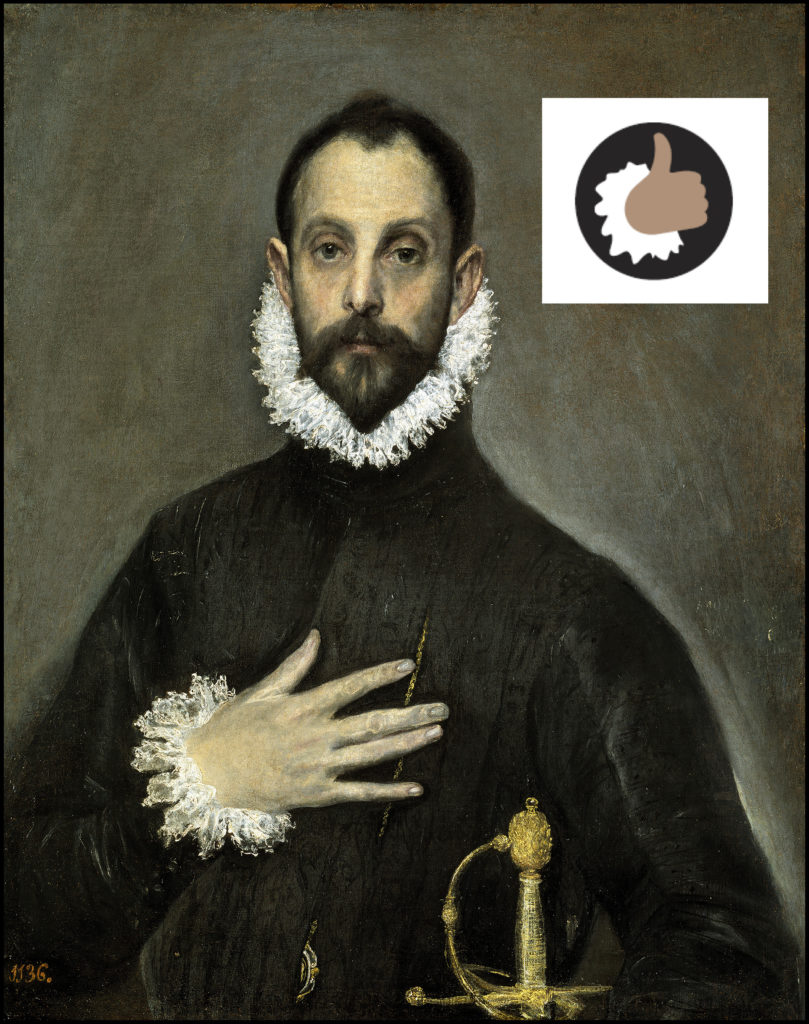Art World
The Prado Museum Unveils a Special Old-Master Emoji to Celebrate Its 200th Birthday
The museum in Madrid has retrofitted the thumbs-up symbol with a lacy cuff inspired by El Greco's famous portrait of a Spanish nobleman.

The museum in Madrid has retrofitted the thumbs-up symbol with a lacy cuff inspired by El Greco's famous portrait of a Spanish nobleman.

Naomi Rea

Madrid’s Prado Museum has launched a very special emoji as part of its 200th birthday celebrations. Just use #Prado200 and an Old Master-inspired version of the thumbs-up emoji will appear to illustrate your tweet. The design of the museum’s emoji features a lacy white ruff based on the one worn by a nobleman in El Greco’s famous portraits El caballero de la mano en el pecho (The Nobleman with his Hand on his Chest) (around 1580).
Now, the museum’s 1.23 million followers on the social media network are having fun with the new emoji. The bicentenary officially begins in January but celebrations kicked off in late November with the sprawling exhibition “Prado Museum 1819-2019: A Place of Memory“, with Queen Letizia and King Felipe of Spain in attendance at the opening on November 19.
Así se realizó el proyecto "Vestir el Prado" que muestra una nueva imagen del Museo durante el Bicentenario #Prado200 #MakingOf pic.twitter.com/GTgkytSFur
— Museo del Prado (@museodelprado) December 12, 2018
The museum’s west façade is currently shrouded in an enormous version of another work by El Greco, La Trinidad (The Holy Trinity) (1577-79). The rest of the museum building is covered in ten more of its most famous canvases, including Diego Velázquez’s The Coronation of the Virgin (1641-44), Peter Paul Rubens’s San Andres (1610-12), and Jusepe de Ribera’s Magdalena penitente (1640-1641). The more than 100,000 square feet of hoardings are part of the “Dress the Prado” project to cover the museum’s building while its undergoes restoration.
The museum has a $13.9 million budget for its bicentenary celebrations, including staging 17 temporary exhibitions. Highlights include “Giacometti at the Prado” running March 2 through July 7. Guest curated by Carmen Giménez, the Guggenheim’s curator of 20th-century art, the exhibition presents Alberto Giacometti’s work in dialogue with key historic works in the Prado’s collection to emphasize its role as a source of inspiration for one of the great Modern masters. In May, a newly restored work by the Italian Renaissance painter Fra Angelico, The Annunciation (1425-26), will be unveiled as the centerpiece of “Fra Angelico and the Rise of the Florentine Renaissance.” Then, in October, 60 works by the female Renaissance painters Sofonisba Anguissola and Lavinia Fontana will be showcased in a watershed exhibition. Meanwhile, works from the Prado’s collection will be exhibited in 30 cities around Spain.
The museum recently announced it is receiving $35 million from the Spanish government over the next four years to support an expansion that will add 27,000-square-feet of exhibition space. Architects Norman Foster and Carlos Rubio have been chosen to renovate the 17th-century Hall of Realms, where Velázquez’s great military paintings, including The Surrender of Breda (1634–35) once hung.